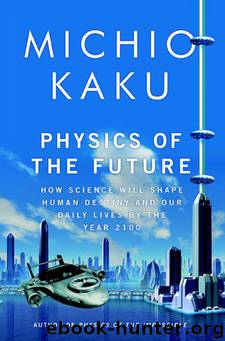Physics of the Future: How Science Will Shape Human Destiny and Our Daily Lives by the Year 2100

Author:Kaku, Michio [Kaku, Michio]
Language: eng
Format: mobi
Publisher: Doubleday
Published: 2011-03-15T05:00:00+00:00
ATOMIC TRANSISTORS
One possible replacement for silicon chips is transistors made of individual atoms. If silicon transistors fail because wires and layers in a chip are going down in size to the atomic scale, then why not start all over again and compute on atoms?
One way of realizing this is with molecular transistors. A transistor is a switch that allows you to control the flow of electricity down a wire. It’s possible to replace a silicon transistor with a single molecule, made of chemicals like rotaxane and benzenethiol. When you see a molecule of benzenethiol, it looks like a long tube, with a “knob,” or valve, made of atoms in the middle. Normally, electricity is free to flow down the tube, making it conductive. But it is also possible to twist the “knob,” which shuts off the flow of electricity. In this way, the entire molecule acts like a switch that can control the flow of electricity. In one position, the knob allows electricity to flow, which can represent the number “1.” If the knob is turned, then the electric flow is stopped, which represents the number “0.” Thus, digital messages can be sent by using molecules.
Molecular transistors already exist. Several corporations have announced that they have created transistors made of individual molecules. But before they can be commercially viable, one must be able to wire them up correctly and mass-produce them.
One promising candidate for the molecular transistor comes from a substance called graphene, which was first isolated from graphite in 2004 by Andre Geim and Kostya Novoselov of the University of Manchester, who won a Nobel Prize for their work. It is like a single layer of graphite. Unlike carbon nanotubes, which are sheets of carbon atoms rolled up into long, narrow tubes, graphene is a single sheet of carbon, no more than one atom thick. Like carbon nanotubes, graphene represents a new state of matter, so scientists are teasing apart its remarkable properties, including conducting electricity. “From the point of view of physics, graphene is a goldmine. You can study it for ages,” remarks Novoselov. (Graphene is also the strongest material ever tested in science. If you placed an elephant on a pencil, and balanced the pencil on a sheet of graphene, the graphene would not tear.)
Novoselov’s group has employed standard techniques used in the computer industry to carve out some of the smallest transistors ever made. Narrow beams of electrons can carve out channels in graphene, making the world’s smallest transistor: one atom thick and ten atoms across. (At present, the smallest molecular transistors are about 30 nanometers in size. Novoselov’s smallest transistors are thirty times smaller than that.)
These transistors of graphene are so small, in fact, they may represent the ultimate limit for molecular transistors. Any smaller, and the uncertainty principle takes over and electrons leak out of the transistor, destroying its properties. “It’s about the smallest you can get,” says Novoselov.
Although there are several promising candidates for molecular transistors, the real problem is more mundane: how to wire them up and assemble them into a commercially viable product.
Download
This site does not store any files on its server. We only index and link to content provided by other sites. Please contact the content providers to delete copyright contents if any and email us, we'll remove relevant links or contents immediately.
The Complete Stick Figure Physics Tutorials by Allen Sarah(7339)
Secrets of Antigravity Propulsion: Tesla, UFOs, and Classified Aerospace Technology by Ph.D. Paul A. Laviolette(5336)
Thing Explainer by Randall Munroe(3911)
The River of Consciousness by Oliver Sacks(3574)
The Order of Time by Carlo Rovelli(3164)
How To by Randall Munroe(3078)
A Brief History of Time by Stephen Hawking(2994)
I Live in the Future & Here's How It Works by Nick Bilton(2963)
What If?: Serious Scientific Answers to Absurd Hypothetical Questions by Randall Munroe(2670)
The Great Unknown by Marcus du Sautoy(2664)
Midnight in Chernobyl by Adam Higginbotham(2520)
Blockchain: Ultimate Step By Step Guide To Understanding Blockchain Technology, Bitcoin Creation, and the future of Money (Novice to Expert) by Keizer Söze(2467)
Networks: An Introduction by Newman Mark(2383)
The Meaning of it All by Richard Feynman(2320)
Easy Electronics by Charles Platt(2310)
The Tao of Physics by Fritjof Capra(2247)
Midnight in Chernobyl: The Untold Story of the World's Greatest Nuclear Disaster by Adam Higginbotham(2200)
Introducing Relativity by Bruce Bassett(2098)
When by Daniel H Pink(2098)
